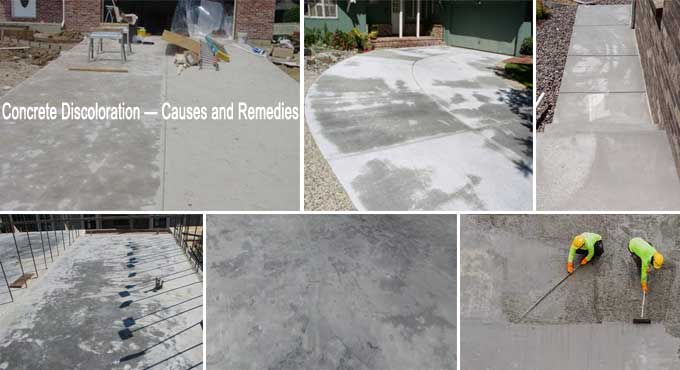NEWS | SOFTWARE | SHEET
The Top 7 Causes and Mitigation Strategies for Concrete Discoloration
Both owners and contractors are unhappy about discolored concrete. There are several ways this might appear in concrete, such as large color variations, light or dark spots, or early light efflorescence. Due to many factors, this is a problematic issue that is difficult to prevent.
Changing cement color, using cement replacements, poor workmanship, and inconsistent mixtures can all cause discoloration in concrete. Immediately after concrete placement, discoloration occurs due to these factors.
Key Reason for Color Discoloration
Water Addition in Construction Site
Concrete with a blotchy appearance is produced by changes in the mix without adequate mixing on the field. To improve workability and make finishing operations easier, contractors can add water to concrete batches.
When concrete is placed side-by-side, the color differences become evident. When tempered concrete is poured next to earlier non-tempered concrete, for instance, water is added to one batch.
Partial Cement Replacement
The percentage of recycled materials used in the mix, water-to-cementitious materials ratio, and method of curing concrete can all affect the color of the concrete when using recycled products as partial cement replacements. Fly ash produces a variety of hues, ranging from buff to brown, when compared with slag, which has a slight green or bluish tint initially.
Material Placement on Concrete during Initial Curing
Plastic, lumber, or construction debris left on colored concrete during the curing process results in blotchy, irregular surfaces, with lighter colors where the materials were placed.
During the critical first few days to weeks after pouring concrete, a curing differential occurs due to different moisture levels at the surface. The key to producing a consistent colored concrete surface is uniform curing.
Concrete surface discoloration can be caused by plastic sheets placed on concrete to improve curing. Spotting is caused by wrinkles or gaps in plastic covers or curing blankets that cause discoloration.
Low Quality Material
In order to avoid unpleasant colors, consistency in mix proportioning is important during the concreting process. The color of concrete will vary from batch to batch at the project site due to differences in batching.
Concrete mixes are also difficult to produce because they contain a variety of materials with inherent variability. There are four main components of a concrete mixture: cement, additional cementitious materials, sand, water, admixtures, and possibly fibers. Different concrete batches interact differently and it is difficult to achieve consistency between them.
Low Level of Labor
Before and during concrete pouring, contractors should consider the weather conditions, as they have a significant impact on the final product. The subgrade should be wetted before concrete is poured on top in a dry environment.
Concrete surfaces can become more variable in appearance and prone to delimitation if dry finishing is performed while bleed water remains on the surface. Additionally, the placement of concrete in hot weather increases evaporation rates, so it may be necessary to use evaporative retarders, windbreaks, or any other appropriate practices.
Cement Color Change
The cement used in ready-mix plants can also change color, causing concrete to discolor. As cement is produced, its color varies due to the conditions under which it is burned or ground.
When a certain cement type is replaced during placement with a different one, or when the adjusted mix is placed immediately next to concrete produced with another cement type, unconventional cement color can have an effect on discoloration.
Too much add Calcium Chloride
It is this substance that causes the appearance of darkened concrete, especially when its dosage approaches two percent by weight. To accelerate concrete's setting time, calcium chloride is generally added to the mixture. Calcium chloride adds to the coloring problem when it is not properly mixed, resulting in irregular or blotchy concrete.
To get more clear ideas, go through the following exclusive construction video tutorial.
Lecturer: Brian Hudgens
Mitigation Strategies of Troubleshooting Concrete Discolor
By using continuous concrete constituents, you can reduce the use of calcium chloride in concrete. A properly poured, finished, and cured concrete will prevent discoloration.
It is recommended to avoid modifying concrete construction practices such as adjusting concrete mix, formwork, curing, all of which are sometimes associated with permanent discoloration of the concrete.


